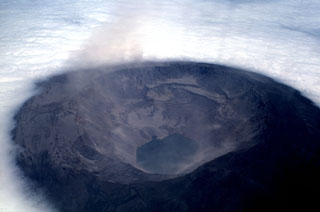Report on Fernandina (Ecuador) — 8 April-14 April 2009
Smithsonian Institution / US Geological Survey
Weekly Volcanic Activity Report, 8 April-14 April 2009
Managing Editor: Sally Sennert.
Please cite this report as:
Global Volcanism Program, 2009. Report on Fernandina (Ecuador) (Sennert, S, ed.). Weekly Volcanic Activity Report, 8 April-14 April 2009. Smithsonian Institution and US Geological Survey.
Fernandina
Ecuador
0.37°S, 91.55°W; summit elev. 1476 m
All times are local (unless otherwise noted)
Based on analysis of satellite imagery, IG reported that an eruption of Fernandina started sometime during 2200 on 10 April and 0030 on 11 April. Several thermal anomalies were seen on satellite imagery, possibly indicating active lava flows. A representative of the Galápagos National Park reported that tourists and park employees observed the eruption during the early hours of 11 April. According to news articles, Galápagos National Park personnel conducting an overflight indicated that the eruption occurred from a fissure on the SW flank, about 500 m from the summit crater. The fissure was 200 m long and 10 m wide, and ejected lava fountains 15 m high. A gas-and-ash plume drifted SW. The eruption took place near the site of the previous eruption in 2005.
Based on analysis of satellite imagery, the Washington VVAC reported that during 11-14 April gas and possible ash plumes drifted up to 370 km W, SW, S, and N. On 14 April, a large thermal anomaly and sulfur dioxide were detected. The observatory also reported smoke from burning vegetation.
Geological Summary. Fernandina, the most active of Galápagos volcanoes and the one closest to the Galápagos mantle plume, is a basaltic shield volcano with a deep 5 x 6.5 km summit caldera. The volcano displays the classic "overturned soup bowl" profile of Galápagos shield volcanoes. Its caldera is elongated in a NW-SE direction and formed during several episodes of collapse. Circumferential fissures surround the caldera and were instrumental in growth of the volcano. Reporting has been poor in this uninhabited western end of the archipelago, and even a 1981 eruption was not witnessed at the time. In 1968 the caldera floor dropped 350 m following a major explosive eruption. Subsequent eruptions, mostly from vents located on or near the caldera boundary faults, have produced lava flows inside the caldera as well as those in 1995 that reached the coast from a SW-flank vent. Collapse of a nearly 1 km3 section of the east caldera wall during an eruption in 1988 produced a debris-avalanche deposit that covered much of the caldera floor and absorbed the caldera lake.
Sources: Agence France-Presse (AFP), Instituto Geofísico-Escuela Politécnica Nacional (IG-EPN), Washington Volcanic Ash Advisory Center (VAAC)

